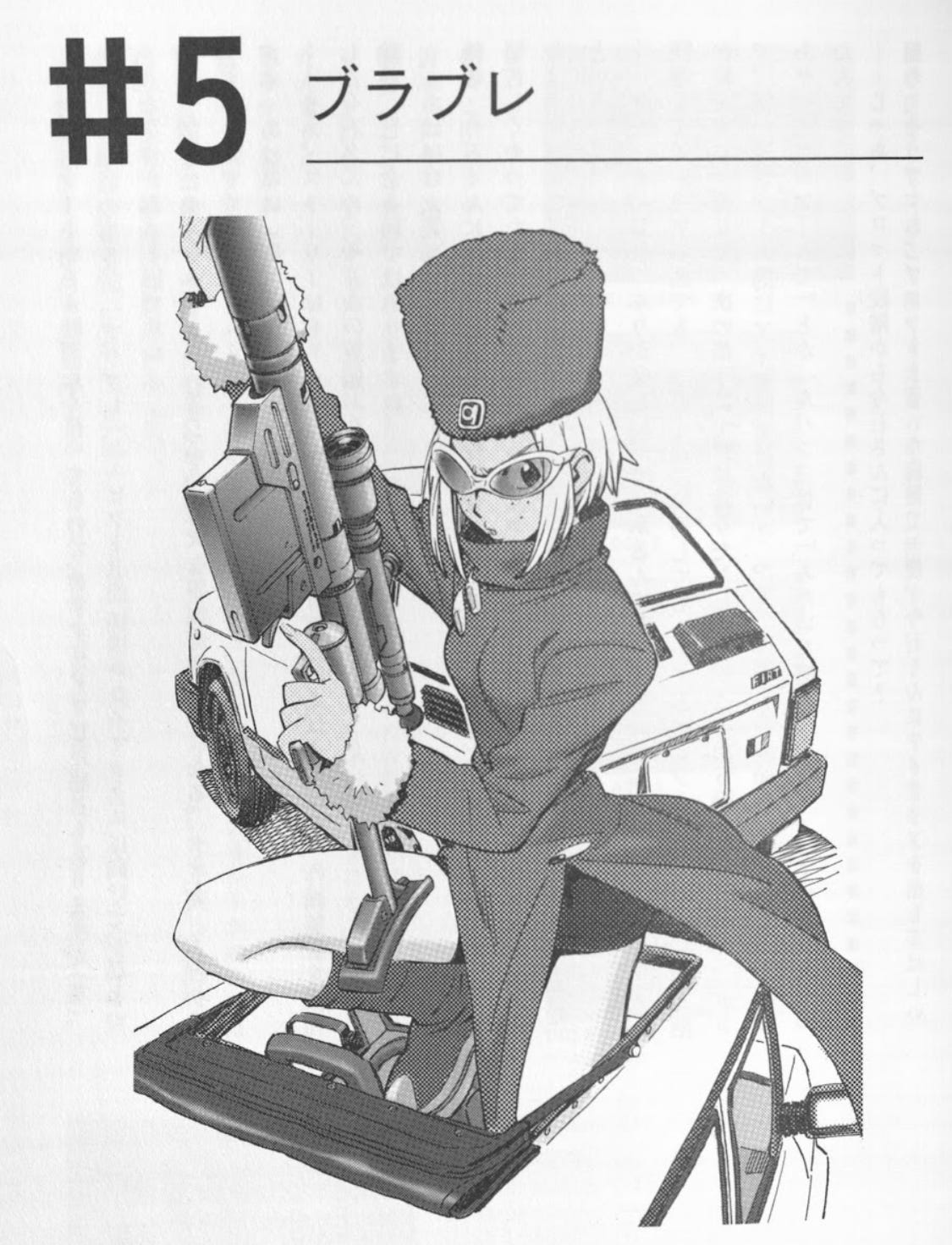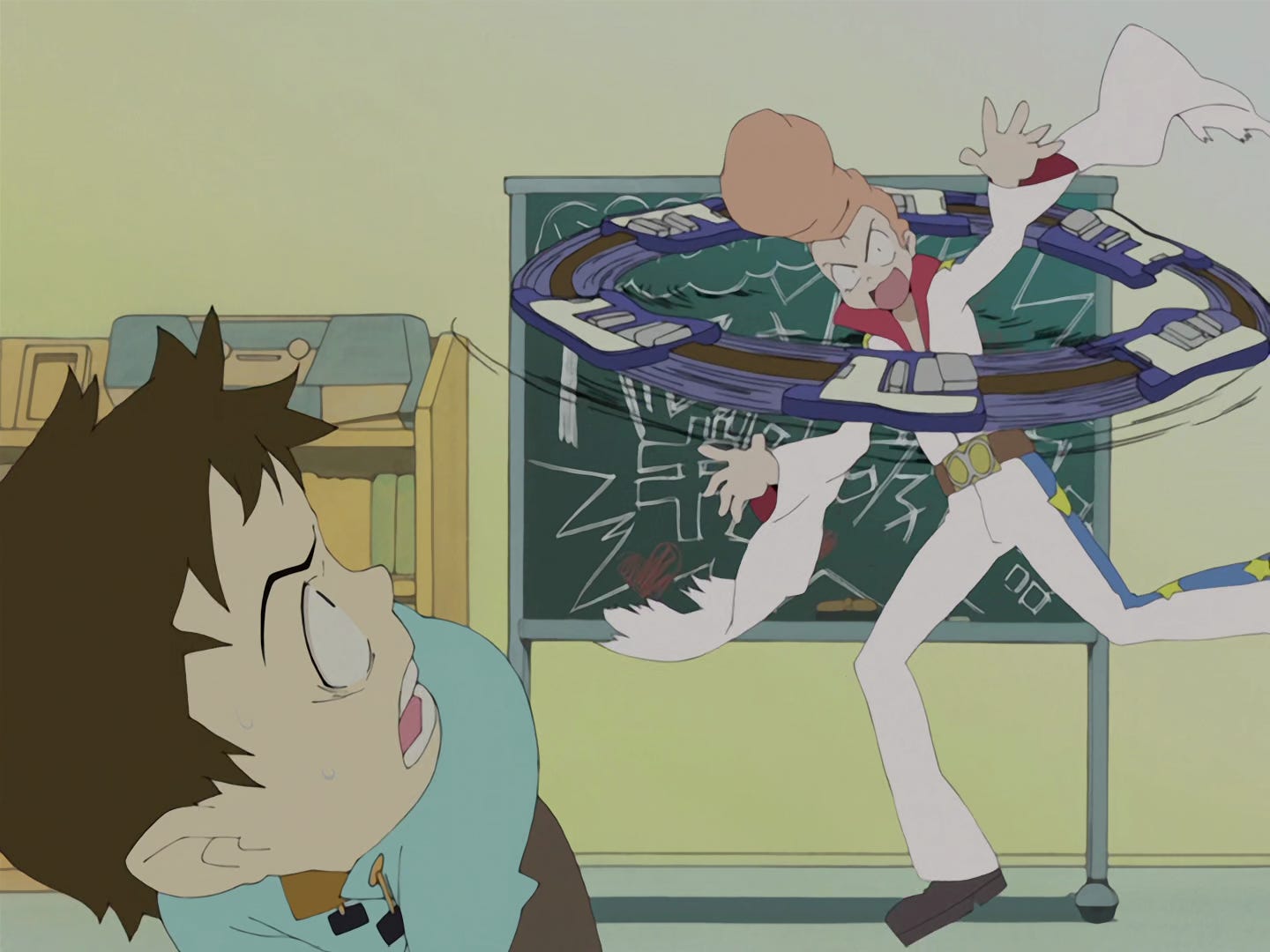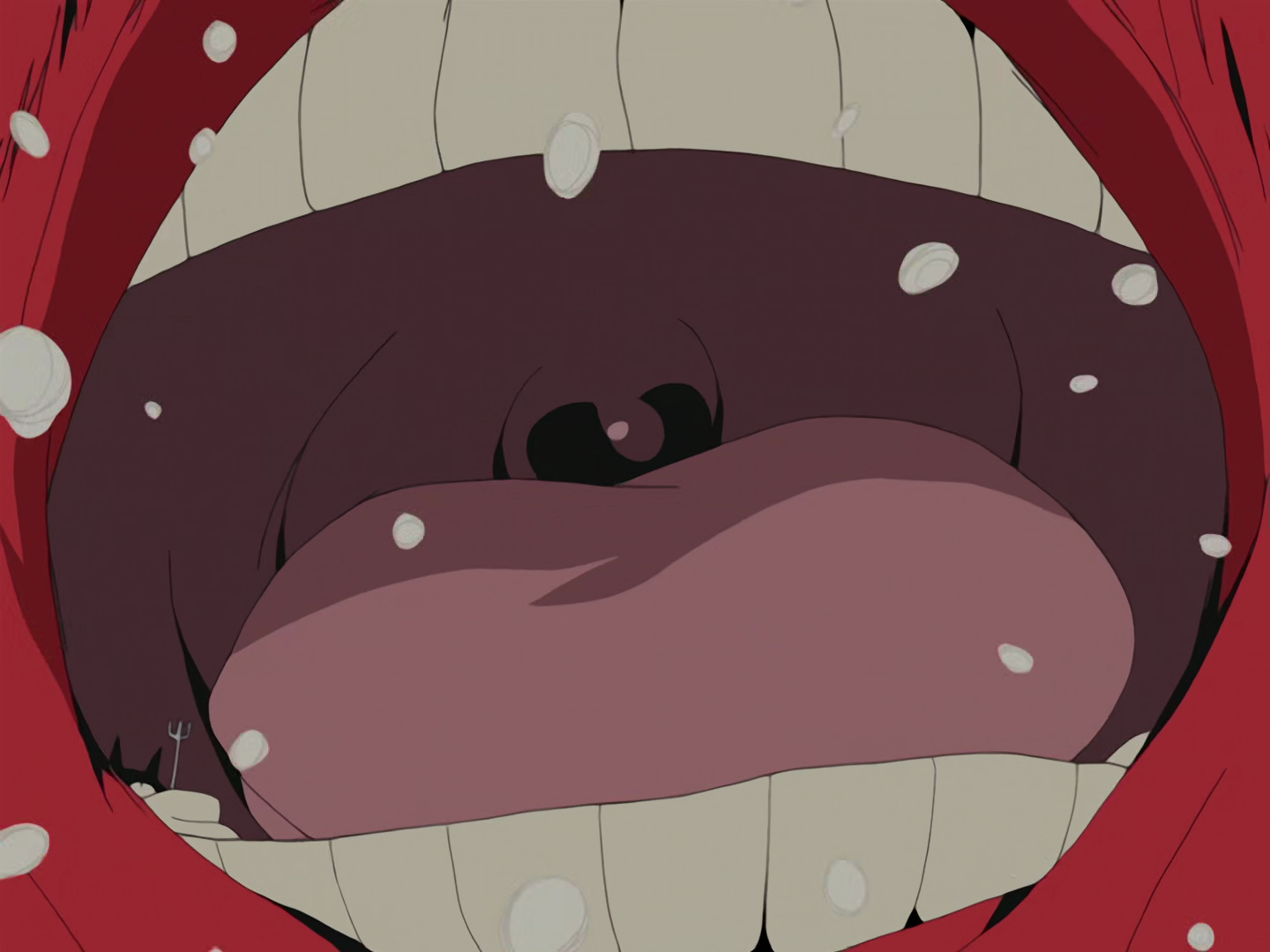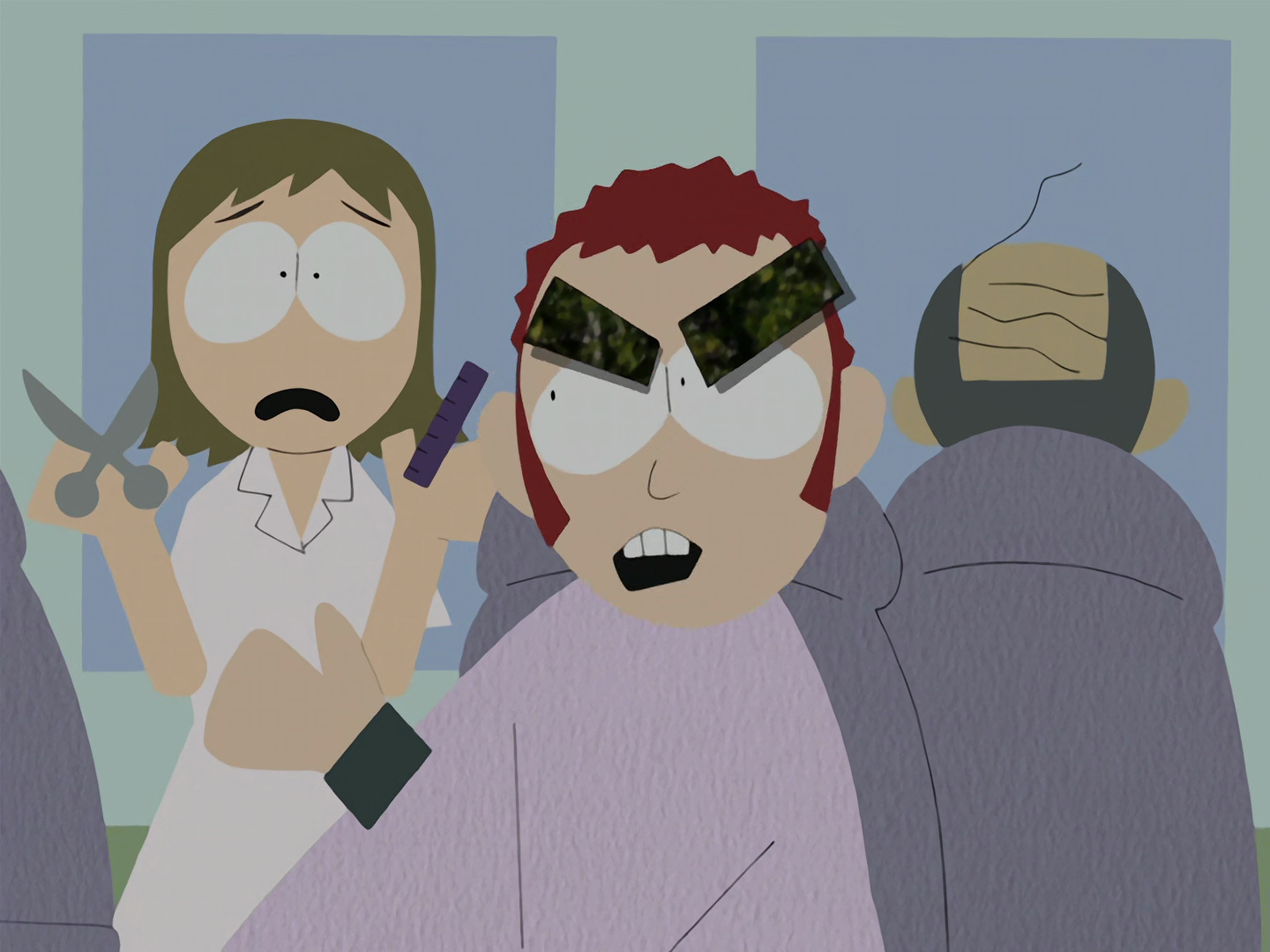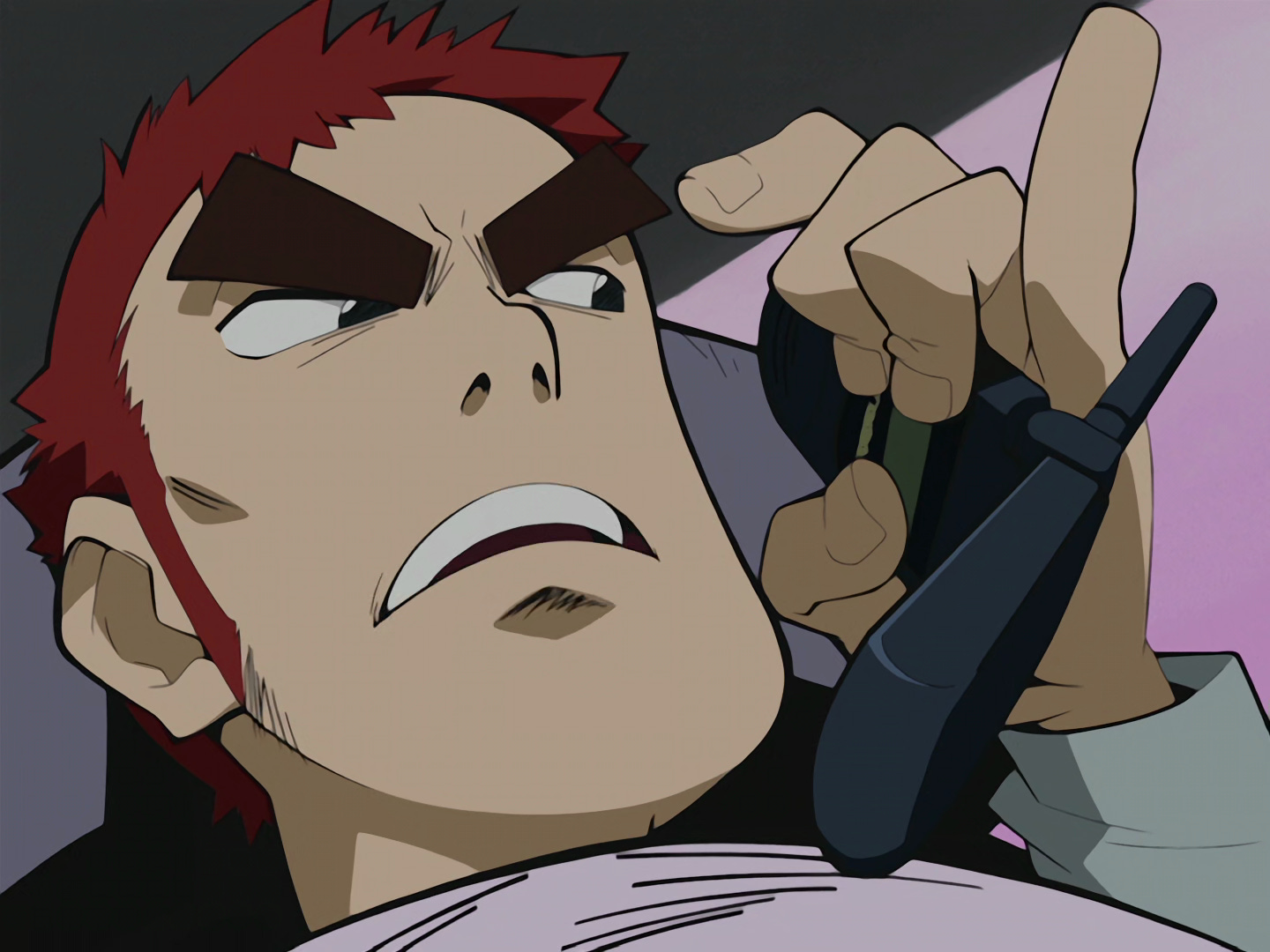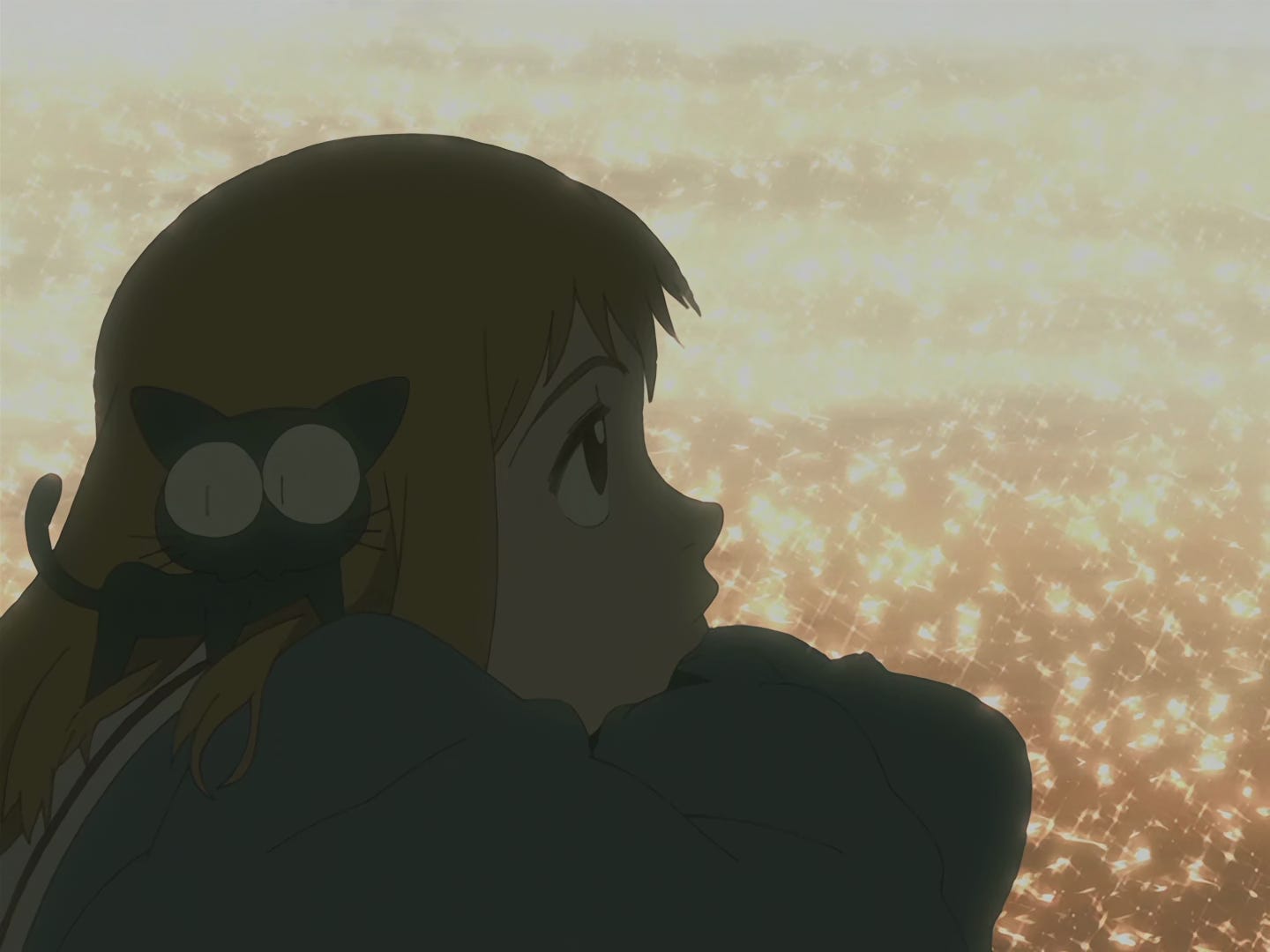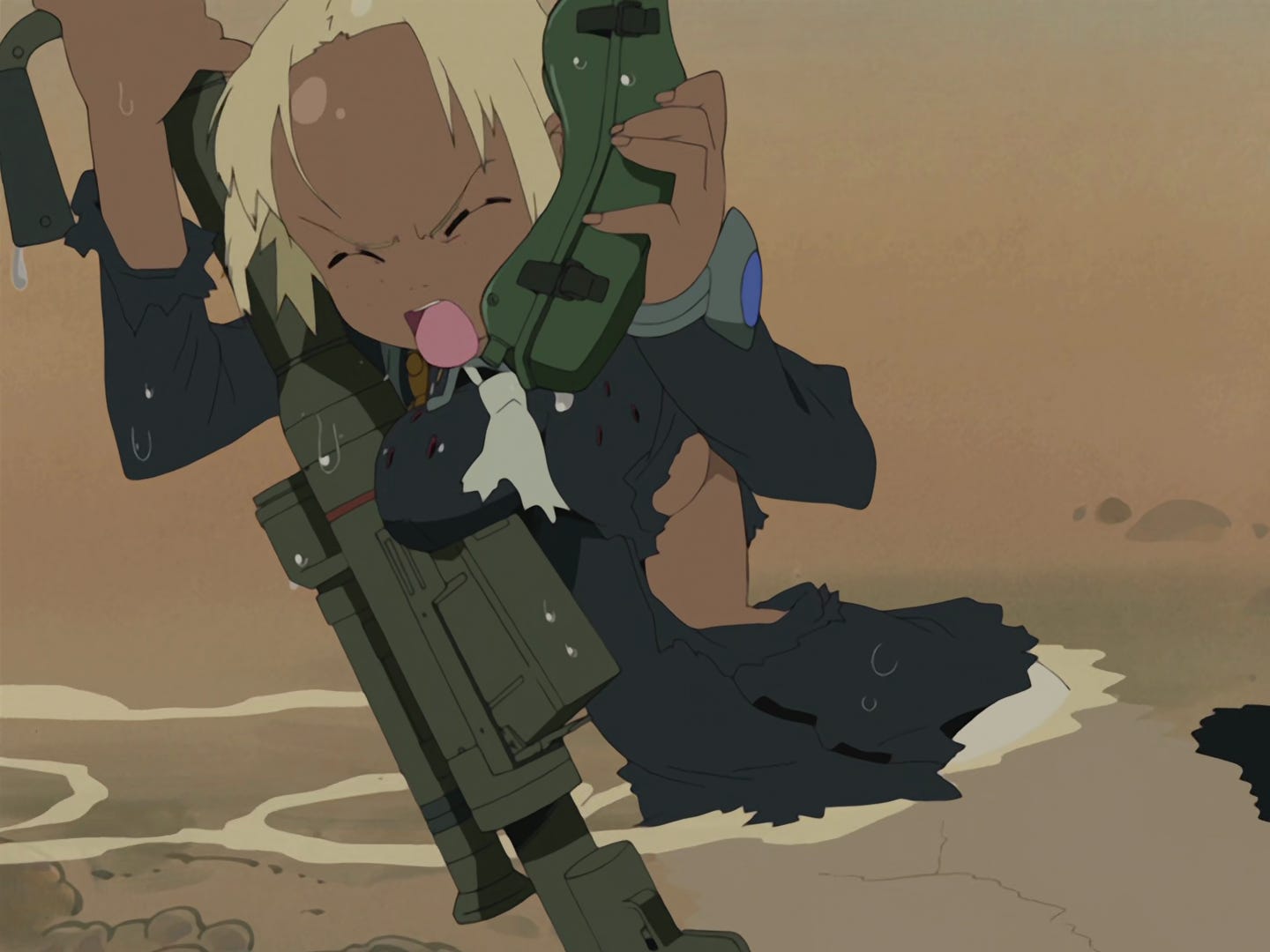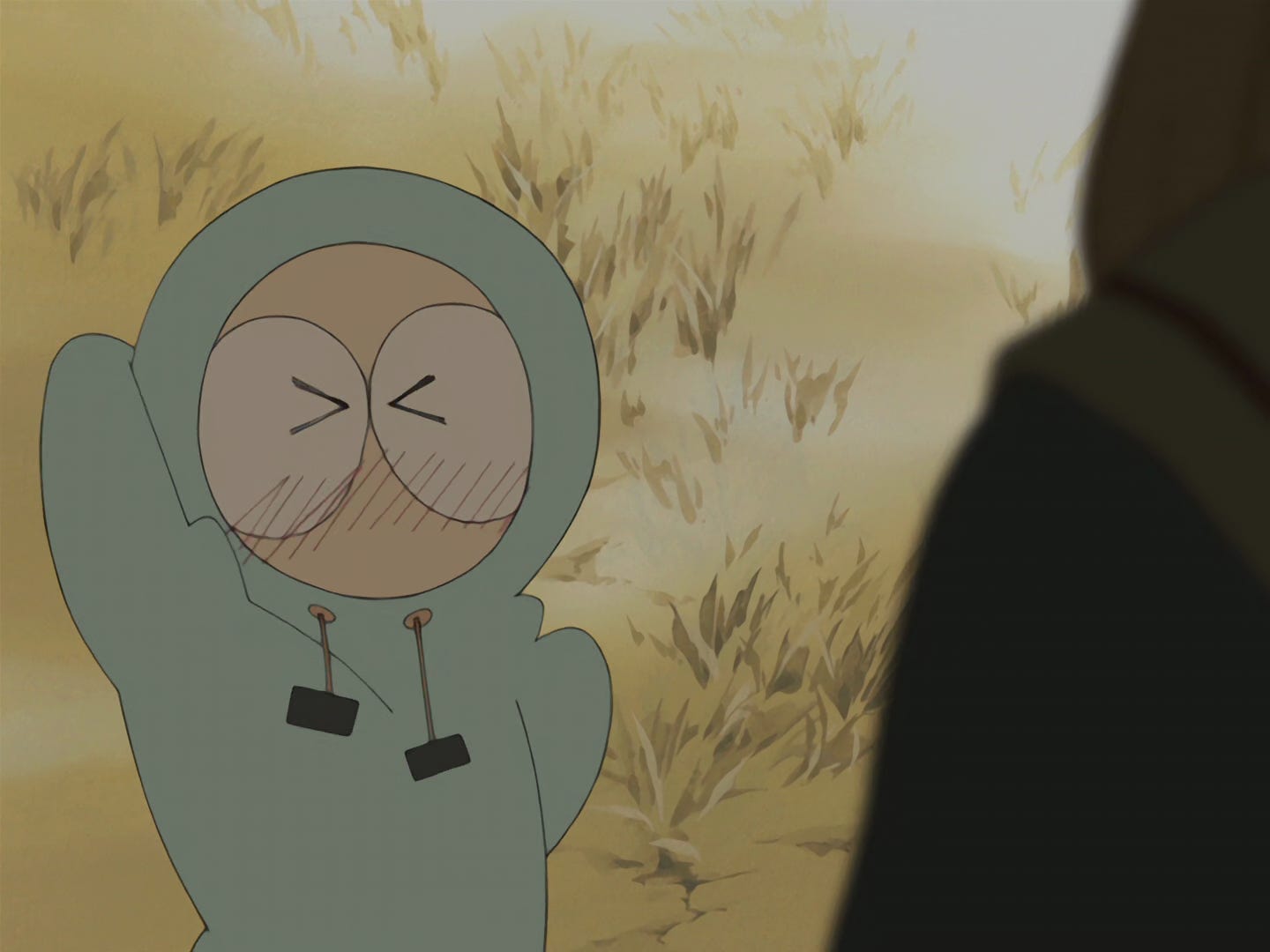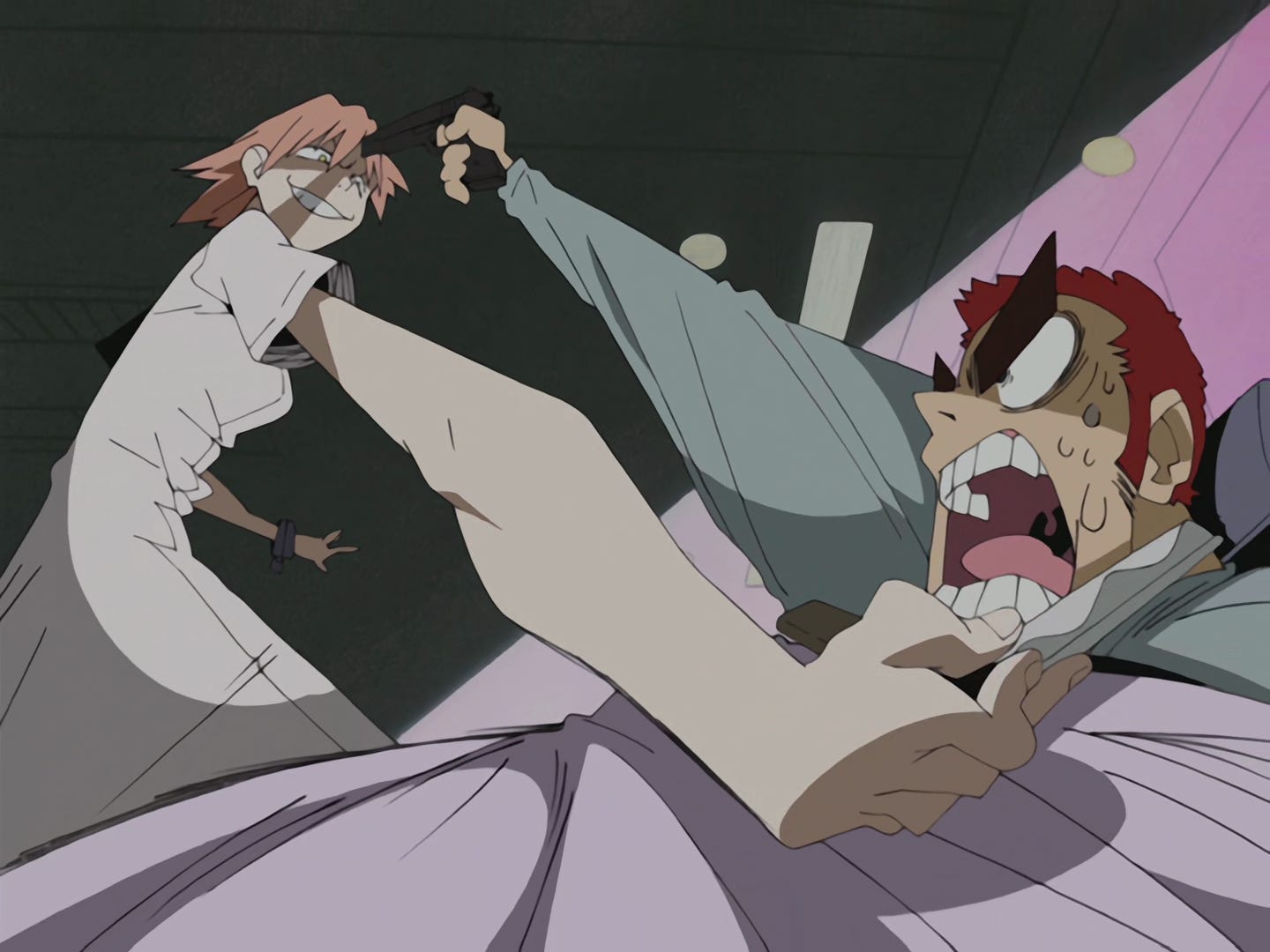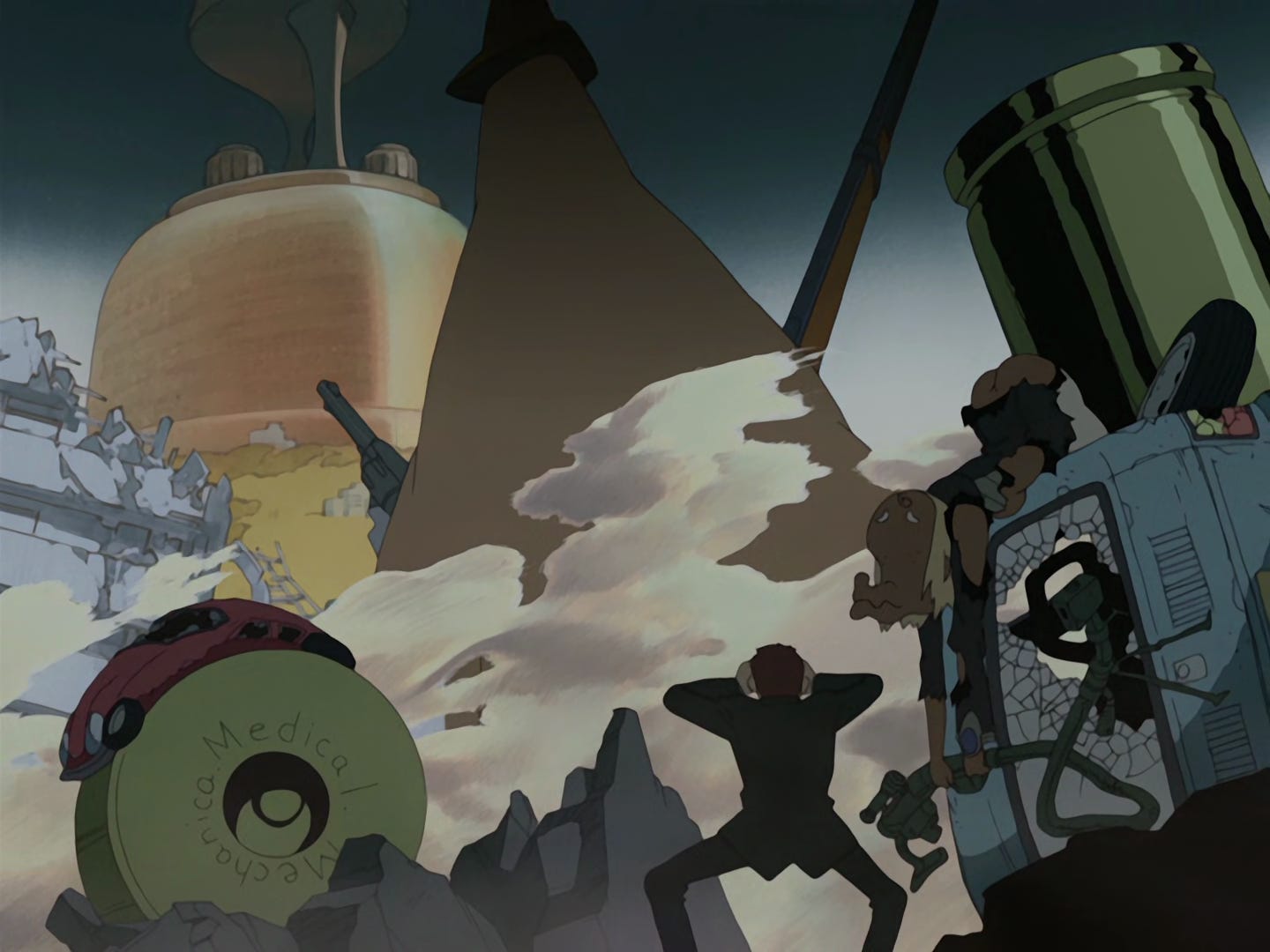FLCLick Noise - Episode 5
[Table of Contents Available Here]
STORY: Naota and Kamon are playing a ‘survival1’ game on the riverbank, while Amarao and the Immigration Bureau monitor them. Naota happens to encounter Ninamori, who tells him that there is a rumor going around that he is the protector of the town. His confidence now high, Naota finally tries to take Mamimi out on a date, but she rejects him. Then, the hammer in Naota's head is released, from which a giant robot appears. Naota declares, "I will protect you!" in response to the threat, but...
Interviewer: It's been almost four hours since the start of the discussion, so I’m fading a bit here (laughs). Finally, we are talking about the fifth episode, "Brittle Bullet," which is a crucial episode leading up to the climax and contains a significant event.
Tsurumaki: For Naota, who is getting a bit cocky, a serious revelation occurs. It's time for Naota's big setback!
Sadamoto: Ahahaha (laughs).
Interviewer: Well, of course, the story is great, but what stands out most in the fifth episode is the free-spiritedness of Imaishi, who served as the animation director.
Tsurumaki: It's tough for your eyes to handle it.
Interviewer: Ahahaha (laughs).
Tsurumaki: I asked Imaishi to be the animation director for the second episode, and he was a bit restrained in his approach. I saw that and thought, "Next time, let’s have him go wild a bit more." So I let him do that, and it turned out like this (laughs).
Interviewer: His unruliness is very enjoyable in this episode though (laughs).
Tsurumaki: Imaishi helped me with the core ideas for this episode as well. If episode 3 was about cats and curry, and episode 4 was about baseball, then episode 5 is about guns. We played with similar association games as before to come up with ideas around the theme of guns, and he came up with the concepts of "survival games" and "Lupin III."
Interviewer: Then, Imaishi was involved even in the plotting stage of production!
Tsurumaki: That's right. Once I had written the core plot, I asked Imaishi to come up with ideas, and then I used what he came up with in the script.
Interviewer: So, did Sadamoto-san design this Elvis Presley? (laughs)
Sadamoto: No, not at all (laughs).
Tsurumaki: This scene was never intended to turn out like this at all, but in the end it came out this way (laughs). Originally, this scene was supposed to be, you know, a nice scene.
Interviewer: The kind of scene where Naota and Haruko kiss, right?
Tsurumaki: It was supposed to be a scene where the slapstick antics from before suddenly transitions into an intimate mood... but we put it in Imaishi’s hands and got this (laughs).
Sadamoto: Kamon has a “cavity bug2” in his tooth (laughs).
Tsurumaki: Ahahaha (laughs). This scene is actually inspired by one of [Kamon’s VA] Matsuo Suzuki's stage performances, where he did an imitation of Lupin III. So, I thought to have him reprise it here (laughs).
Interviewer: Did you intend for this be a slapstick episode?
Tsurumaki: Well, in terms of the script, I don't think it was significantly different from other episodes. But when it came to how to express those ideas in the storyboards and how to depict them in terms of animation, it ended up going in that direction, yes. I discussed it with Imaishi, and we decided it was okay to be free and not to restrict ourselves too much. So, to some extent, I anticipated it would turn out like this.
Interviewer: Sadamoto, you didn't expect that the character of the work would be messed with so heavily, did you?
Sadamoto: Yes, that's right. I thought that the more mellow feeling from the first and second episodes would continue. Though, once we reached this point, I also was thinking, "Go ahead, do whatever you wish!"
Tsurumaki: This part is all thanks to [Shinji] Otsuka. He's an amazing talent, but he's also the one who goes totally out there the most (laughs).
Interviewer: Otsuka is not someone who only does that kind of animation, right? (laughs).
Tsurumaki: He's someone who has also worked as an animation director at Studio Ghibli. He did things like this here precisely because it's something that can't be done elsewhere. Like, "It's allowed in FLCL!" (laughs).
Interviewer: Ahahaha, should we maybe stop here for a bit (laughs)? Was this okay to make?
Tsurumaki: I don't know, I just did it without knowing whether it was okay or not (laughs).
Interviewer: This was originally part of Imaishi’s storyboards, right?
Tsurumaki: That's right.
Interviewer: Some people may not understand, but this is pulled from the American paper cutout animation technique...
Tsurumaki: It's actually made with CG.
Interviewer: ...as used in the show "South Park3". It's a parody of that, right? In the fourth episode, during the scene where [the teacher] Miya-jun's car breaks down, a "South Park" keychain briefly appears as well; it's very present throughout the show.
Tsurumaki: That’s because we all loved the show (laughs). I loved it, and Imaishi loved it too. Though, I didn't expect to go quite this far with it.
Sadamoto: Even in that previous cut with Amarao, it has a bit of an American comic or cartoon-like feel to it. The outlines are thick, and the hair looks like a broomstick (laughs).
Interviewer: But since it's not really shown anywhere that this actually happened, I thought the haircut scene was imaginary at first. And then later, you realize, "Oh, Amarao really did cut his hair" (laughs).
Tsurumaki: Yes, it’s a scene that really flips itself on its head4. (While watching Kitsurubami aiming her sniper rifle at Canti) This scene here was also terrible of us to do, where from the sound of the word "Sabage" (survival game), it associates with "saba" (mackerel) and further connects to "Sabageruge" (mackerel game). It's just more meaningless word association games (laughs). But to come up with the dialogue for this part, Enokido and I stayed up all night.
Interviewer: In the DVD release, it's hard to track what's happening on screen.
Tsurumaki: Yes, in the intense action scenes, the motion becomes noisy due to the compression; but I think it looks cleaner in the Blu-ray version.
Interviewer: What does this "Masamune" here [on Naota’s classmate’s car] mean?
Tsurumaki: Well, it's the surname of the classmate who drives the car. This guy's family runs a liquor store, and even though he's an elementary school student, he does delivery part-time and knows how to drive. Maybe this idea is from Enokido; it's like while Naota and the others are fooling around with survival games, his classmate is driving a car and doing adult work. It's a contrast like that.
Interviewer: It makes you realize how childish you are being.
Tsurumaki: The key animation here is done by Hiramatsu. Initially, the car the classmates were riding in was just a light truck. But I think Hiramatsu suggested making it a three-wheeler.
Sadamoto: Yes, that sounds like something he would like.
Tsurumaki: Well, I was hoping to create a more fun and interesting setting. The script also says that Masamune and [the other classmate] Gaku might like Ninamori. And driving along the riverbed is not a violation of the law (laughs).
Tsurumaki: Looking at it now, the sparkling surface of the water is amazing.
Sadamoto: Yeah, I've never seen anything like it before.
Tsurumaki: At that time, it was still the early days of digital filming, so we were in the trial and error stage, figuring out how to achieve this or that kind of effect and when to use them. That's why even though it's the same water surface, the sparkling effect in the first episode is completely different from this one.
Sadamoto: They are different, yeah.
Tsurumaki: And here! (Looking at Kitsurubami with torn clothes). This is the scene we were talking about when discussing the second episode. I don't think there was an explicit call for a scene of Kitsurubami half-naked in the initial script.
Sadamoto: For Kitsurubami?
Tsurumaki: Yeah, Kitsurabami. So, I think this scene is a fanservice scene in the sense that Imaishi added it into the storyboards directly, but for a fanservice scene it's not offering that much fanservice. Actually, I think it would be more erotic to emphasize her being wet more actively, don't you think? (laughs).
Sadamoto: That is to say, this is Imaishi's choice, right? (laughs)
Tsurumaki: It reflects Imaishi's tastes, yes.
Sadamoto: Who did the voice for that character again?
Interviewer: It's Chiemi Chiba5.
Tsurumaki: I liked "Ojamajo Doremi" [which she starred in]. And finally, here it's revealed that Amarao really was at the barber shop (laughs).
Sadamoto: The "South Park" scene wasn't a lie, huh? (laughs).
Interviewer: (while looking at Naota standing by the riverbed again) And "South Park" comes back one more time (laughs)6.
Tsurumaki: We really loved it, huh.
Tsurumaki: This scene is something Imaishi really wanted to do.
Sadamoto: A shootout at a barber shop.
Tsurumaki: It’s very John Woo-esque7.
Interviewer: In the beginning of Episode 5, there's even a scene with the trademark flying doves. This [barbershop] scene was completely left up to Imaishi, right?
Tsurumaki: Yes, we pretty much entrusted the whole scene to him. This part (Haruko passing through the slow-motion bullets) came out a bit different from what I had in mind. Half of it was supposed to be Haruko transforming into a kind of energy form, leaving her physical body, and dodging the bullets while moving forward. Originally, the action would also have this science fiction meaning to it; but when you actually see the scene, it just looks like a typical [Yoshinori] Kanada-style8 effects-heavy sequence (laughs).
Sadamoto: It's totally an effects-focused scene (laughs).
Tsurumaki: It ended up feeling like we drew it on impulse, and now its like "Huh?" (laughs). It would have been better if it had been a bit more of a serious and lifelike scene. When you draw in this timing and style, the result lacks rawness and realism.
Interviewer: (Referring to the café called "Cafe Bleu" that Naota and Mamimi visit) Where did the name "Cafe Bleu" come from?
Tsurumaki: This was Enokido's idea. It's from The Style Council's album, "Café Bleu9". In Enokido's plan, Naota was supposed to take Mamimi to a love hotel, but that seemed strange for an elementary school student to do. So we made Naota take her to a café that was drawn to look like a love hotel, but is still a cafe in the end... but it's not really coming across (laughs).
Interviewer: Ahahaha (laughs).
Tsurumaki: It's quite amazing for an elementary school student to take a high school girl to a café, right? That's the idea.
Sadamoto: Well, it does say "Rest Here" on the sign, so I think it comes across (laughs).
Tsurumaki: (Returning to the scene of Haruko and Amarao's confrontation) I described this part [in the initial scenario] as Haruko using her guitar like a magical transformation wand, but well, I didn't actually draw this scene, so I don't really understand what is happening (laughs).
Interviewer: So Haruko and Amarao knew each other previously, right?
Tsurumaki: That's right. Probably, when Amarao was around the same age as Naota, they met. Amarao was presumably being used by Haruko, and was subsequently discarded. Amarao might be Naota's future self; it was that kind of relationship.
Interviewer: The designer of this robot is...
Sadamoto: Is it Yoshitsune Izuna10?
Tsurumaki: That's right. The idea was to have him wear a ten-gallon hat, a cape, and carry a Winchester lever-action rifle.
Sadamoto: Ah, real shoot-out style.
Tsurumaki: Yes, we wanted the design to be like a drifter from a Western film. And here (when Mamimi calls out Naota's brother's name), it becomes clear that Mamimi still loves his brother.
Sadamoto: This part [Naota’s piloting of Canti] is cool.
Tsurumaki: We later find out that this coolness is actually a misunderstanding. That's why we portrayed it as excessively cool, as in reality it has the opposite meaning. This part here (when Haruko charges through the smoke and explosions) is really well done, drawn by Yoshinari. This explosion has been imitated in other anime as well, hasn't it?
Interviewer: (Naota as a bullet hits the movie sign) what is this part about?
Tsurumaki: Well, this is a joke around the plot of a yakuza film "Aesthetics of a Bullet" where, [similarly to that film’s plot], it turns out Naota isn't piloting Canti but rather being used as ammunition (laughs).
Interviewer: I forced you to explain the gag, didn't I? (laughs)
Tsurumaki: Ahahaha! However, in this part, both the action and composition are so dynamic, I love it.
Interviewer: (Amarao and others watching the battle) Kitsurubami is going through a lot here.
Tsurumaki: It's pretty terrible.
Sadamoto: Hahahaha (laughs). What is up with her face?!
Interviewer: (Atomsk pulls out his guitar-weapon) Why is it a Gibson11?
Tsurumaki: I was looking for a cool-shaped guitar, so I searched around, and the EB-0 had this Batman-like style to it, very cool. But having the name "EBO" was a bit of a problem (laughs). If it were something like "Stingray" or "Specter," it would sound like a killer move, but "EBO" doesn't really have that ‘killer move’ vibe even if you shout it (laughs).
Interviewer: Well, it's like a symbol or something, right?
Tsurumaki: However, if we added "1961 Model" to it, we thought it could become a joke. Like, "What's with a special move called the '61 Model'?" That's the idea, It's that kind of joke. I ended up explaining the joke again, didn’t I (laughs).
Interviewer: Well, since Episode 5 is a comedy episode, I guess there's no other choice but to explain the jokes (laughs).
Tsurumaki: Actually, considering the ideas and themes present, I think it would have been interesting enough to structure the episode in a serious way (laughs). But by making it a comedy, we took an outside approach to it instead.
Interviewer: Did you purposely choose to take it in that different direction?
Tsurumaki: It was less about that intent, and more that I wanted to play to Imaishi’s strengths. If I can achieve that by shifting to a different approach, then that is fine. And if it can express what I want to convey and that different approach makes it even more interesting, then I don't mind that either. It might have been possible to wrap up the entire series in a poetic and subdued tone, and that might have been my personal preference, but that isn’t enough to make it satisfying. It might have been a "good anime," but it wouldn't have had the strength to make people still love it even after ten years.
Interviewer: Was Gainax in a situation at that time where they were shifting towards this kind of direction for animation?
Tsurumaki: Yeah, after "Neon Genesis Evangelion," the lineup of animators changed quite a bit. It was inevitable for a generational shift to happen. Additionally, "Eva" was a work that imposed strict constraints on the animators. It had a directing method that enforced a specific style, and on top of that, it demanded high quality, so it wasn't an environment for nurturing young talent. After that, for the anime "Kare Kano", we let people like Shouji Saeki12 and Imaishi have more freedom, and as a result our young animators developed significantly, and even younger animators than Imaishi were attracted to that kind of freedom and joined in. That's why I personally wanted to unleash the power contained within that freedom, rather than confining myself to a strict drawing style. Though maybe it doesn't have to be as free as it is here (laughs).
Sadamoto: Ahahaha (laughs).
Interviewer: So, that was the 5th episode... Sadamoto, are you tired? (laughs)
Sadamoto: No, I just don't have much to say (laughs).
Interviewer: From your perspective, Sadamoto, do you think that the fifth episode is a bit too manga-like?
Sadamoto: No, I do like watching, but...
Tsurumaki: How about "The Gutsy Frog”?
Sadamoto: I really love "Dokonjo Gaeru." But I prefer the "Shin" (New) version [from 1981] more than the "Kyū" (Old) one [from 1972].
Tsurumaki: Ah yes, I also tend to prefer the "Shin" version.
Sadamoto: However, among the animators involved, there are those who prefer the "Kyū" version. I personally have a strong admiration for Osamu Kobayashi13, so I really love the "Kyū" version. But the "Shin" version is also great, right? When I say the "Shin" version is great, I mean it in terms of its overall characteristics, like the art being good, the exaggerated movements being interesting, things like that. Kobayashi’s animation had reached a higher level of artistry, so the drawings themselves are undoubtedly better in the "Kyū" version. However, in terms of the episodes, the "Kyū" version is mainly focused on gags, while the "Shin" version has several heartwarming, dramatic moments, and some episodes can really make you cry. The "Shin" version doesn't receive much attention, but I think it's still really good.
Interviewer: Oh that reminds me, in Episode 5 there's a discussion about the jacket color of "Lupin III", right?
Tsurumaki: Ahahaha, the red jacket vs green jacket14, right? (laughs)
Interviewer: When I interviewed Sadamoto before for an issue of the magazine Continue15, the color of Lupin's jacket came up as an example of how he and you ultimately failed to understand each other (laughs).
Tsurumaki: Ahahahahaha! (bursts out laughing)
Sadamoto: When we first met, Tsurumaki told me, "I prefer the red jacket." But I think Imaishi probably prefers the green one, right?
Tsurumaki: Well, I guess so.
Sadamoto: It’s because he is a bigger A-Pro16 fan.
Tsurumaki: Oh no, it's just that I didn't watch the first Lupin series (with the green jacket) while it was airing. I actually watched the second series ( with the red jacket) live, so in that sense, the second series feels more like "my Lupin III." Of course, there are many bad episodes in the second series, but there are a bunch of episodes that I like. If I watch just those, the second series is entertaining enough.
Sadamoto: Oh yes, I see. It was a part of my youth as well (laughs).
Tsurumaki: Yeah, yeah. For example, in the final episode of the first series of "Lupin III," [Hayao] Miyazaki's approach is, in my opinion, truly interesting. The staff of the first series made something that stood as a complete denial of the approach of the second series. And since it's the final episode, there's no room for rebuttal. When I realized that later, I thought, "Wow, that's amazing!" I find it interesting to watch the first series and the second series thinking of them as opposing axes.
Sadamoto: Also, there's the film "Mamo" ("Lupin III: The Mystery of Mamo"), right? Osamu Kobayashi and Tsutomu Shibayama, who participated in both the first and second series, were involved in that one. It seems like they made it with a ton of enthusiasm, saying, "This is how Monkey Punch's 'Lupin' is supposed to be!" So, even if you watch the whole TV series, I think "Mamo" is the piece of media that feels closest to Monkey Punch's vision for "Lupin”.
Interviewer: In Episode 5, the theme of intergenerational conflict is very present, and I wonder how much it was intentional to bring in "Lupin" as part of that.
Tsurumaki: In "FLCL," we use red and blue to signify conflicting elements. Haruko's side is portrayed with red and other warm colors, while Naota's side is always portrayed with blue.
Sadamoto: So, Naota's blue is like a "Lupin" reference, then?
Tsurumaki: No, it's not like that (laughs)。
Sadamoto: Well, because even Kanti changes from blue to red (laughs).
Tsurumaki: Ah, I guess you can interpret it that way. But also, since everyone enjoyed the "Tomino-esque" line in the first episode17, I thought it would be fun to bring in that kind of reference one more time. So, there was only Miyazaki left to use for that (laughs).
TN: Generally what is called airsoft gun games in other countries, though it can be a little broader in Japanese
TN: A pun in Japanese - the word for “cavity” contains the word for “bug” in it.
An American animated TV series that has been airing since 1997. It is created by Trey Parker and Matt Stone and is known for its contrasting cute art style and dark, satirical storytelling. A theatrical film version was released in 1999.
TN: This is a line that I am not sure on, I must admit. Tsurumaki is saying “投げっぱなしバックドロップです” making a metaphorical reference to a wrestling “throw-back suplex” move. I believe he is referring to the scene transition being a sudden twist, but this is only a guess.
A voice actress from Saitama Prefecture. She originally worked as a model and stage actress under the name "Burei." She transitioned to voice acting and achieved success as the protagonist Harukaze Doremi in "Ojamajo Doremi," which started airing in 1999.
TN: Just in case, in this scene Naota is drawn to look like the character Kenny from South Park
A film director born in 1946 in Guangzhou, China. He gained attention with his 1986 film "A Better Tomorrow," which depicted the story of men living in the underworld of Hong Kong in a hard-boiled detective style. He later moved his activities to the United States in the 1990s and directed films like "Mission: Impossible 2" (2000). He is known for his unique style, including using slow-motion for action scenes; he also frequently features flying doves in his works, and the appearance of the doves in the beginning of Episode 5 of "FLCL" is an homage to John Woo.
TN: Kanada has been discussed before, but in this case its important to note that his heavily stylized, frenetic approaches to action became something of a “school of animation” that artists in animation refer to as a concept. Imaishi is one of the most famous “followers” of this school; if you want way more detail you can check out Animetudes essay on the topic here
A soul/pop unit formed in 1983 [TN: actually 1982] and led by Paul Weller, former guitarist and vocalist of The Jam (who disbanded in 1990). The name for the coffee shop that Naota and Mami try to enter is a reference to their first album "Cafe Bleu".
TN: A career mecha designer who also worked with Tsurumaki on Diebuster. He also made an adorable Mamimi keychain.
A guitar manufacturer in the United States that produced many famous guitar models, such as ES-150, Les Paul, Flying V, etc.
An animator born in 1971 in Kanagawa Prefecture. He was Involved in independent animation production since university days and, after joining Gainax, participated in works such as "His and Her Circumstances" and "Mahoromatic" as a storyboard artist and director. In "FLCL," he was involved in episode 3 as a storyboard artist and episode director, and he was the episode director for episode 5 as well. In 2004, he directed a TV series for the first time with "This Ugly Yet Beautiful World."
An animator born in 1945 in Tokyo. Participated mainly in Tokyo Movie works such as "Lupin the Third," "Attack No.1," "The Gutsy Frog," and directed works such as "Together with Nontan" after establishing Ajia-do Animation Works with Tsutomu Shibayama in 1978.
The TV anime "Lupin III" had two series: the first series (commonly known as the "Old Lupin"), which aired in 1971, and the second series (commonly known as the "New Lupin"), which aired from 1977. In the second series, Lupin's jacket color was changed from green to red. The first series aimed to push the medium of adult-oriented animation genres, while the second series was produced with more mainstream appeal in mind in response to the popularity of reruns of the first series. The two series had different artistic directions, and in Episode 5 of FLCL, this difference is referenced through the topic of the color of Lupin’s jackets.
Featured in the magazine "Continue", issue 50 (published by Ohta Publishing). [TN: It was part of a wider feature that also involved Tsurumaki, the issue in question is this one here]
TN: The studio that made the first, “green jacket” Lupin III series
TN: This is referencing a line from Kamon in the ‘moving manga’ sequence of episode 1, about Gundam and its creator Yoshiyuki Tomino


